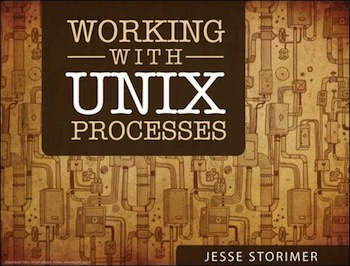Unix for Ruby Developers
24 Dec 2012 It is gratifying to know that learning something tangentially related to Ruby will, in fact, teach me more about Ruby.
It is gratifying to know that learning something tangentially related to Ruby will, in fact, teach me more about Ruby.
Working With Unix Processes, by Jesse Storimer, is ostensibly about Unix internals. However, in reading this book, I have become more aware of how executables run on my favorite family of operating systems, which in turn gives me more insight into Ruby.
Passing Arguments
For example, what happens when we pass arguments to a process, Ruby or otherwise? How do the arguments get there? Storimer offers a 1-line Ruby program called argv.rb that we can use to play with the ARGV array:
~/Code/Ruby/apps/sandbox$ echo 'p ARGV' > argv.rb
~/Code/Ruby/apps/sandbox$ ruby argv.rb what results can we expect here
["what", "results", "can", "we", "expect", "here"]
~/Code/Ruby/apps/sandbox$
Once we have our hands on the ARGV array, we can parse it and manipulate it at will.
Grokking Forks
The section on forks contains a lot of mind-bending fun. The author offers some code to explain how forks work, but some concepts are only understandable when we write our own code. I had to write my own in order to raise my comfort level with forks.
Here’s what the code does:
- In the parent process,
forkreturns thepidof the child process. - In the child process,
forkreturnsnil. - Therefore, the
ifblock should be executed by the parent process… - …and the
elseblock should be executed by the child process.
puts "Parent process pid (before fork) is #{Process.pid}.\n"
if fork
current_process = Process.pid
parent_process = Process.ppid
printf "Entered the *if* block during Process #{current_process}."
printf "\nThe parent of this process is #{Process.ppid}, which should be bash.\n\n"
else
current_process = Process.pid
parent_process = Process.ppid
printf "Entered the *else* block during Process #{current_process}."
printf "\nThe parent of this process is #{parent_process}, which should be the original of this process.\n\n"
end
Running the above Ruby code produces the following results:
~/Code/Ruby/apps/sandbox$ ruby forking_around.rb
Parent process pid (before fork) is 79703.
Entered the *if* block during Process 79703.
The parent of this process is 76751, which should be bash.
Entered the *else* block during Process 79704.
The parent of this process is 79703, which should be the original of this process.
Digging further: Let’s look at the names that correspond to our
pids.
~/Code/Ruby/apps/sandbox$ ps -p 79703
PID TTY TIME CMD
~/Code/Ruby/apps/sandbox$ ps -p 79704
PID TTY TIME CMD
~/Code/Ruby/apps/sandbox$ ps -p 76751
PID TTY TIME CMD
76751 ttys003 0:00.40 -bash
~/Code/Ruby/apps/sandbox$
We get zero data for the pids 79703 and 79704 because those processes terminated with the program forking_around.rb. However, 76751 shows bash because bash is still running.
The book is full of rich playground examples that go much deeper than this. Time slips away when I get rolling with this stuff!
Errata Handling
The book is new so you can expect a few typos. If you run into problems with sample code, a quick Google search will lead you to the corrected text. For example, early in the book I had problems with a command that returns the maximum number of processes allowed on a system. Turns out there was a typo, and the correction was posted by the author himself on the publisher’s errata page.
Conclusion
I enjoyed reading Working With Unix Processes because it replaces a belief in “the magic of Unix” with a sound understanding of Unix fundamentals. The book is clear and brief with plenty of examples. The author assumes that readers have at least a basic understanding of Ruby. After that, you only need a command line, IRB, and the willingness to explore.



